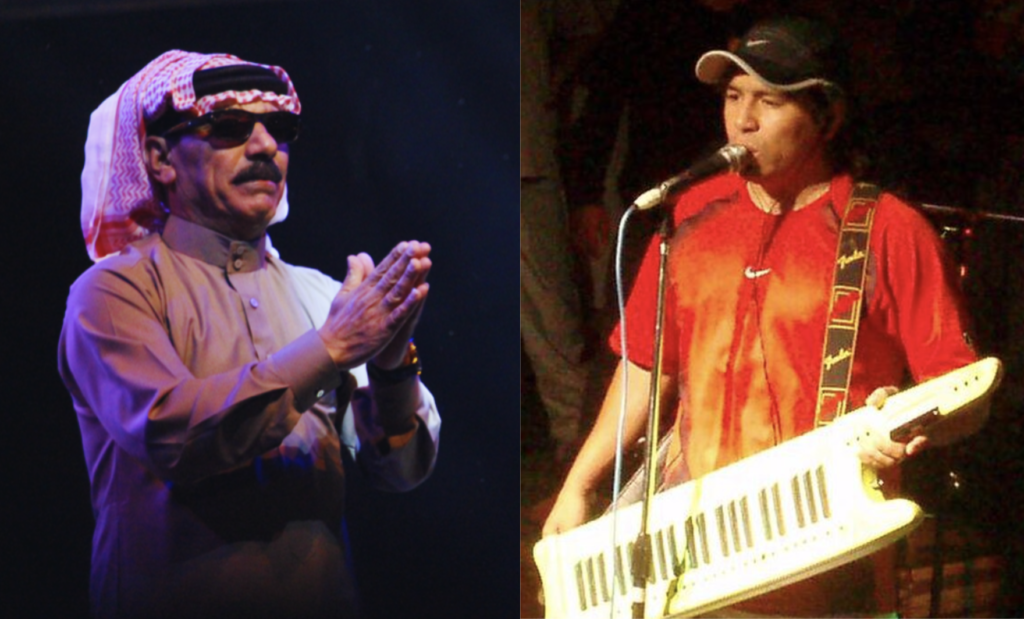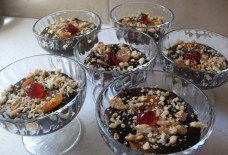Transcontinental Tones: Arabic Rhythms Meet Latin Vibrations

By: Nissrine Bedda / Arab America Contributing Writer
As a child of an Arab/Latin family, I often experience a whirlwind of emotions during family gatherings. Our table is a delightful mix of Arab dishes like hummus, shawarma, and mansaf, paired with salsa and platters of jalapeños. When it comes to music, I watch as my Mexican relatives dance everything from Dabke to Omar Suleyman, mirroring each other’s movements with ease. The blending of these two cultures, separated by the Atlantic, is so seamless that it’s hard to distinguish between them. It’s clear that music, in both Arab and Latin cultures, brings our communities together, especially through tough times. It’s fascinating how two distinct cultures can so effortlessly harmonize in rhythm and spirit.
I often notice that the movements in Latin rhythms are reminiscent of those found in Levantine and Maghreb music. These days, it’s common to be at a Latin club and suddenly hear some Dabke or even tracks by Cheb Khaled or Shakira’s “Ojos Así.” This song, in particular, was one of the first introductions to Middle Eastern rhythms for the Latin community, with its upbeat percussion inspiring curiosity about Arab culture. When I’ve talked to friends from Mexico to Argentina, they frequently say things like, “I don’t know why, but Arabic music brings something out in me! I can’t explain it; it’s just a feeling.” Their responses only fueled my desire to learn more. So, let’s dive in!
Flamenco and its Moorish Origins
The roots of this cultural clash trace back to 711 to 1492, when Moroccans exerted colonial power over Spain and the Iberian Peninsula. This period saw a nearly “forced” blending of distinct Western and Maghreb cultures, particularly evident in music. The imposition of one culture over another led to a hybridization that reshaped musical traditions, intertwining sounds and styles in ways that were often beyond the control of those involved. Later, we see the rise of Flamenco, a traditional Spanish dance that merges with Moorish rhythmic beats and footwork. Particularly in Bulerias, a characteristic type of Flamenco that comes from the word burlar (“mockery” in Spanish).
When you listen to flamenco guitar, you can hear a rhythmic clapping called compas, along with a singer expressing strong emotions through their lyrics. For first-time listeners, it can feel overwhelming, as you might wonder if the performer is crying or shouting, especially with the dramatic Andalusian rhythm in the background. For Arab listeners, the way words are stretched in a song like Bulerias might remind them of home, similar to hearing the Adhan during prayer times.
It’s not only the mimicking of sounds that you may hear, but the sudden rush of emotions that may connect you to your soul leaving you content or melancholic.
Cumbia
The lovely rhythms brought into a cumbia can light up a room of people, encouraging everyone to get up and dance, no matter their cultural background. The emergence of cumbia can be traced back to Colombia’s coastal region and it was originally an African courtship dance that evolved with the addition of African, European and indigenous instruments and indigenous dance steps. The controversy of where cumbia originally started is always a conversation starter for cumbia lovers, especially Mexico and Argentina where you can hear cumbias all throughout the streets, at weddings, or any sort of family gathering. Depending on the region you’re looking at, you can hear the same beat carried out, but the different instrumentation and rhythms varying from region to region can mark the preference of cumbia you like.
Cumbia Sonidera, which originated in Mexico, and Argentine Cumbia are favorites among many in the Latin community, especially in the U.S. Their infectious rhythms make them not only catchy but also incredibly fun to dance to. It’s no coincidence that cumbia evokes such passion; for Spanish speakers, the lyrics often reflect themes of hardship, love, and abandonment. In fact, many of the most viral cumbieros (“cumbia musicians”) come from the most impoverished areas of their countries.
Cumbia Villera in Argentina and Syrian Influence
Argentina, a nation that has been dealing with a hyperinflation crisis since the start of the 1980s left many citizens in poverty. While many may have needed to emigrate out of their country, cumbia always followed them along through personal struggles which led to the emergence of other forms of cumbia like RKT, a subgenre of cumbia mixing reggaeton and trap music, as well as cumbia villera (“cumbia from the streets” in Spanish).
Cumbia villera is typically accompanied by un teclado ( a keyboard in the form of a guitar), making it easier to distinguish between different cumbia sub-genres. Now, this is when the mix of cultures gets exciting! It’s known through RioPlatense countries like Chile, Uruguay, and Argentina that there has always been an influx of Syrian migrants pre-Arab Spring. In fact, Carlos Saúl Menem , Argentina’s president in the late 1980s, was of Syrian descent. His parents were Syrian nationals from Yabroud who had emigrated to Argentina. This hybridity of cultures is what makes music carry a certain rhythmic pattern, especially when it comes to Argentinian cumbias.
Listening to a cumbia villera, you might notice the familiar Syrian keyboard sounds, reminiscent of the cadence found in the songs of Omar Suleyman, the Syrian techno-pop artist. This keyboard often mimics the sound of Middle Eastern bagpipes. You can easily identify Argentine cumbia by its distinctive teclado introduction, which builds anticipation for the beat drop into the classic cumbia rhythm. As you listen to the song, can you distinguish the differences in rhythm between cumbia villera and Colombian cumbia, for instance? In online comments about Argentine cumbias, many people express how the rhythms evoke memories of their childhood back home in Syria. It’s fascinating to realize that a sound so familiar from my own upbringing—where my grandma would play cumbias while preparing to clean—could have these Arabic rhythmic connections. It truly makes me feel the music coursing through my veins.
Mexican Zapateado and Moroccan Chaabi
Finally, we have Mexican zapateado. If you’ve ever been to a Mexican wedding or quinceañera, you might have witnessed the traditional zapateado performed by family members. The term zapateado comes from the Spanish word zapatear, meaning to strike or tap down with your shoe. This dance form originated from Spanish flamenco, and when Spanish conquistadors arrived in Latin America, South American gauchos (cowboys) would gather around campfires to dance in their leisure time. Today, you can see how this dance has evolved, often performed in a circle during special occasions.
Zapateado elements are often incorporated into live Banda music, a vibrant Mexican orchestra featuring trombones, trumpets, clarinets, and guitars that enliven events. The lively rhythms of Banda can sometimes echo those played by clarinetists at Moroccan weddings, generating a similar energy that keeps guests engaged and entertained.
Jarabe or Xarabe?
Another form of zapateado is Jarabe Tapatio, which originates from Guadalajara, Jalisco. This Mexican state is notable for its strong Spanish and Arab influences throughout the country. Jarabe Tapatio is a courtship dance typically performed by a man and a woman, where the man invites his partner into a world of intimate affection. Initially, the woman rejects his advances, but she gradually warms to his persistence as they dance, only to reject him again when her positive signals lead to his overwhelming excitement. The word “jarabe” comes from the Arabic term “xarabe,” referring to an herb mixture that symbolizes the fusion of indigenous and Spanish cultural dances into one cohesive expression.
One common thread linking these rhythmic patterns is the fusion of Spanish flamenco elements, including distinctive footwork and instruments introduced during Moorish colonization. This fusion has influenced various cultures, particularly in Latin America. When you listen to Moroccan Chaabi music at weddings, you can hear, feel, and see the same dance footwork found in Jarabe Tapatio. We discover that Moroccan Chaabi music has “musical roots that can be found in Andalusian music, but it possesses much of the poetic and musical freedom that Andalusian music lacks.”
Suddenly, everything comes full circle. Spanish colonization has had far-reaching effects, including economic hardship and Western imperialism. Yet, despite this, cultural elements like music have evolved to connect communities affected by colonization. Across oceans, people share the same rhythms, cultural influences, and dance styles, coming together to celebrate and cherish each other’s heritage.
Check out our blog here !








